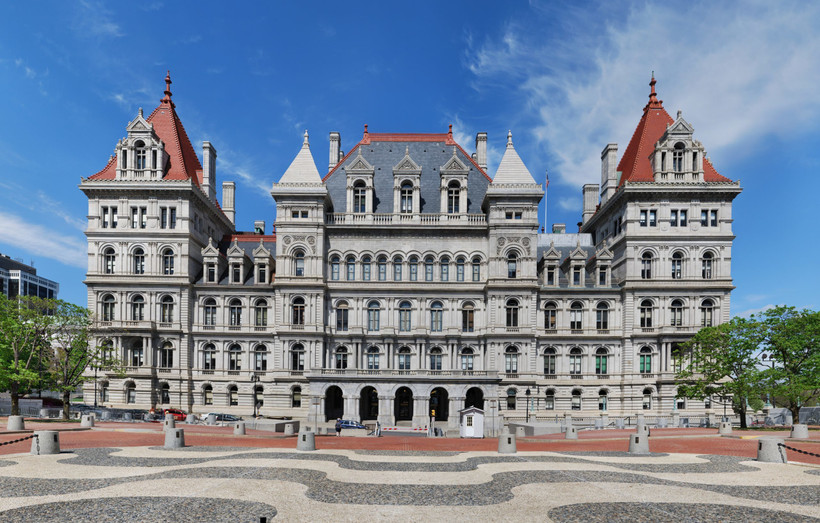Lessons to be learned from New York’s climate policy laboratory
New York is seen as a model - but it also shows the challenges of green public-private partnerships

Published in partnership with the Financial Times.
New York has established itself as something of a laboratory for US climate policy, vying with California to offer a model for the green programmes that loom large in Biden’s economic plans. The state’s clean energy efforts and its approach to financing them could provide a template for national action.
But a closer look shows that — even in a wealthy liberal stronghold — political will, statutory mandates and a streamlined approval process for large renewable energy projects may not be enough to hit climate targets.
The state has sought to boost renewables with subsidies for wind and solar. But former governor Andrew Cuomo, who signed bold climate targets into law in 2019 and pushed to build wind farms off New York’s coast, opposed plans to pay for the transition by taxing the rich or charging polluters.
Two years after New York’s Climate Act passed, the state has not yet committed the substantial funding needed to achieve its ambitious decarbonisation plans. Without it, state shortfalls — and the absence of an unequivocal signal to markets — could deter the businesses and financial institutions whose support will be essential to meet the targets.
New York’s reluctance to fund climate action could resonate in Washington as congressional Democrats consider establishing a federal accelerator to beef up the green banks that are now found across the country.
Biden tapped Ali Zaidi, the New York climate policy chair who worked closely with New York Green Bank (NYGB), to be his deputy national climate adviser. And the president has modelled other programmes on New York, such as his Justice40 Initiative, which aims to deliver 40 per cent of the benefits of federal investment (an ill-defined category) to disadvantaged communities (a term also awaiting definition).
With Biden looking to New York for inspiration, a national green bank could duplicate NYGB’s rapid achievement of self-reliance — and, more controversially, how it identifies projects at the frontier of commercial viability.
Slow progress
New York’s Climate Act was always expected to require a multi-decade overhaul of existing policies. It calls for the state to reach net-zero emissions by 2050, with an interim goal of a 40 per cent cut in emissions from 1990’s levels by 2030.
The state now awaits recommendations from a council charting the course to achieve those goals, and early signs have alarmed climate activists. The state environmental agency is confident New York will be on track to hit its targets once suggestions from the council’s advisory panels are incorporated, but those panels say even if their proposals are adopted, most sectors will still fall short of the economy-wide target for the next decade.
The power sector — previous governors’ bête noire — is promising to carry much of the green transition on its shoulders, hauling in 70 per cent of electricity from renewable sources by 2030. But New York’s biggest emitters are moving sluggishly. “New York State is much, much further along in achieving its electricity goals than its buildings and transportation goals,” said Anne Reynolds, director of the Alliance for Clean Energy New York. The transportation advisory panel is proposing just a 16 per cent reduction from 1990 levels by 2030.
These challenges mirror the national situation: even as Congress granted the Federal Energy Regulatory Commission more power to over-rule states in greening the grid, it shaved down infrastructure bill funding for transit and housing.
Green banking to electrify buildings
Clean electricity is the backbone of the energy transition — everything else plugs into it. New York’s buildings consume more fossil fuels than those in any other state, so hooking up residential and commercial complexes to a greener grid would dramatically reduce pollution.
Buildings also must be electrified by swapping equipment such as furnaces, boilers and washing machines for non-fossil alternatives.
New York has so far leaned heavily on regulation — passing legal mandates that don’t require state funds. Already, though, a ban on gas hookups in new buildings in New York City met squeals from developers, who will be required to identify clean energy sources before breaking ground.
Upgrading the city’s stock of existing buildings will be costlier and more complex. A new rule has set air pollution caps on roughly 50,000 properties, but has met with similar pushback from landlords, who must pay to comply with regulations or face steep fines.
The city still lacks a plan to electrify most of its more than 1 million buildings, says Amy Turner, an expert on city climate law at Columbia University, but state financing could help.
Without such a nudge, private lenders rarely participate in untested and hyperlocal green projects, which then struggle to get off the ground. Conveniently, New York boasts the nation’s largest green bank.
Regional green banks across the US catalysed $1.6bn in clean energy investment in 2020, according to the American Green Bank Consortium. That brings the total investment they have mobilised since 2011 to $7bn, including $1.9bn of their own funds.
Last year New York Green Bank, created in 2013 with funding from utility ratepayers, committed around $350m toward projects including improved energy efficiency, solar and fuel cells.
NYGB pitches itself as a European-style green bank at the bleeding edge of the commercial market, which focuses on wrapping projects, taking the risk of first loss, and “warehousing” financing for securitisation to help lenders cash out of illiquid loans. Since 2017, the returns on its loans have covered its operating costs.
But some say it hasn’t yet lived up to its mandate to seek out “market gaps” — projects that struggle to access capital elsewhere — and has instead been more conservative, favouring more mature markets. One example is Sunrun, a publicly traded, 14-year-old company that has received more than $100m to accelerate its solar installations at homes across New York. The company’s share price soared to $100 in January, but has since sunk back to $45, down 10 per cent from one year ago.
“Sunrun is a phenomenal company, and they’ve done tremendous work to help develop the solar market. But given its success, it seems safe to assume that Sunrun in 2020 likely had access to other sources of capital,” said Adam Zurofsky, New York’s former deputy secretary for energy and finance. “My question is whether there were other great projects that could have used these public dollars — the kind of assistance a green bank can uniquely provide.”
NYGB says it is now “strengthening our focus on projects for which private capital is not as readily available, such as affordable housing building electrification.”
Its early insistence on building self-sustaining markets could also put NYGB’s strategy in tension with the Climate Act’s demand that more than a third of benefits must flow to poorer areas.
Even with Wall Street in its backyard, NYGB hasn’t yet made this work at scale. It has committed to spend $150m on affordable housing, but this may fall short of the sum required to spark a building electrification boom.
“Green banks are focused on activities that generate a return, but when you actually get down to it, there are a lot of things to do with environmental justice that someone’s just going to have to spend money on,” said Jeff Schub, executive director of the Coalition for Green Capital.
New York has some of the country’s oldest housing, where long deferred maintenance related to structural integrity — mould, asbestos, and electrical upgrades — is often needed before undertaking major energy innovation.
Some NYGB-funded undertakings have included “environmental justice” components, such as an affordable housing community’s rooftop solar project, which yielded such high cost savings that the building operator could afford to install free Wi-Fi for tenants.
But win-win projects that efficiently decarbonise the economy, benefit the poor and generate returns remain tough to scale.
New York plays defence
Activists argue that some climate hurdles cannot be regulated away or privately financed. Transportation is a case in point. Biden is a longtime rail commuter who championed the $24bn infusion that Amtrak, the nation’s largest passenger railroad, recently received to modernise its north-east corridor.
And yet, said Bob Howarth, a Cornell ecologist who sits on the council drafting New York’s decarbonisation plans, “no one is talking about serious mass transit.” Partly, that’s a culture war problem. Trains and buses in the United States are seen as expensive services for the poor, rather than public goods, which can leave transit in a vicious cycle of underfunding.
Instead of building new trains or scaling up bus systems, Howarth said, New York has focused on switching motorists to electric vehicles (EVs). This emphasis on cars matches much of the US, where soaring costs have held back mass transit buildout. The $1tn infrastructure bill which has passed the Senate included no money for high speed rail.
To speed EV uptake, New York could go beyond banning fossil fueled cars — another regulatory inducement it is considering — and pay motorists to trade in their vehicles. Instead, its climate council appears poised to recommend a mix of affordable financing options and a revenue-neutral “feebate”.
As New York’s leaders look to limit emissions from old polluters, meanwhile, new ones are emerging. An exposé on an old coal plant being revved up to burn natural gas for cryptocurrency mining sparked widespread outrage. Atlas Holdings, the private equity firm that owns that mining operation, hired a top-dollar public affairs firm while it sought state permits.
A proposed ban on crypto mining, including Atlas’s plant, was one of a bevy of climate bills that could not gain traction during the 2021 legislative session. But if crypto miners — who have little existing foothold in New York — could stymie climate regulation, activists worry, real estate and fossil fuel interests stand a better chance.



